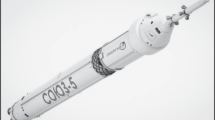Abstract
A three-dimensional numerical simulation model that considers the effect of the angle of attack was developed to evaluate plasma flows around reentry vehicles. In this simulation model, thermochemical nonequilibrium of flowfields is considered by using a four-temperature model for high-accuracy simulations. Numerical simulations were performed for the orbital reentry experiment of the Japan Aerospace Exploration Agency, and the results were compared with experimental data to validate the simulation model. A comparison of measured and predicted results showed good agreement. Moreover, to evaluate the effect of the angle of attack, we performed numerical simulations around the Atmospheric Reentry Demonstrator of the European Space Agency by using an axisymmetric model and a three-dimensional model. Although there were no differences in the flowfields in the shock layer between the results of the axisymmetric and the three-dimensional models, the formation of the electron number density, which is an important parameter in evaluating radio-frequency blackout, was greatly changed in the wake region when a non-zero angle of attack was considered. Additionally, the number of altitudes at which radio-frequency blackout was predicted in the numerical simulations declined when using the three-dimensional model for considering the angle of attack.
Similar content being viewed by others
References
M. Kim, M. Keidar and I. D. Boyd, J. Spacecraft Rockets 45, 1223 (2008).
C. Thoma, D. V. Rose, C. L. Miller, R. E. Clark and T. P. Hughes, J. Appl. Phys. 106, 043301 (2009).
Y. Takahashi, K. Yamada and T. Abe, J. Spacecraft Rockets 51, 430 (2014).
J. D. Huba, NRL Plasma Formulary (Naval Research Lab., Washington, D.C., 2000).
Y. Takahashi, K. Yamada and T. Abe, J. Spacecraft Rockets 51, 1954 (2014).
K. S. Kunz and R. J. Luebbers, Finite Difference Time Domain Method for Electromagentics (CRC Press, Boca Raton, 1993).
N. Kawano, H. Kihara and K. Abe, Proceedings of the 5th Asian Joint Workshop on Thermophysics and Fluid Science (Nagasaki, 2014).
Y. Wada, Y. Watanabe, T. Akimoto and H. Yasui, Special Publication of the National Aerospace Laboratory SP-24 (1994), p. 227.
Ph. Tran, J. C. Paulat and P. Boukhobza, NATO Rept. RTO-EN-AVT-130-10, 10-1 (2007).
C. F. Curtiss and J. O. Hirschfelder, J. Chem. Phys. 17, 550 (1949).
R. N. Gupta, J. M. Yos, R. A. Thompson and K. P. Lee, NASA RP-1232 (1990).
M. Fertig, A. Dohr and H. H. Frühauf, AIAA Paper 1998-2937 (1998).
M. Fertig, A. Dohr and H. H. Frühauf, J. Thermophys. Heat Trans. 15, 148 (2001).
C. Park, J. Thermophys. Heat Trans. 7, 385 (1993).
C. Park, R. L. Jaffe and H. Partridge, J. Thermophys. Heat Trans. 15, 76 (2001).
C. Park, Nonequilibrium Hypersonic Aerothermodynamics (Wiley, New York, 1990), p. 35.
C. Park, J. Thermophys. Heat Trans. 18, 527 (2004).
J. G. Parker, Phys. Fluids 2, 449 (1959).
R. C. Millikan and D. R. White, J. Chem. Phys. 39, 3209 (1963).
C. Park, AIAA Paper 1984-1730 (1984).
J. P. Appleton and K. N. C. Bray, J. Fluid Mechanics. 20, 659 (1964).
M. Mitchner and Jr. C. H. Kruger, Partially Ionized Gases (Wiley, New York, 1973).
M. Nishida and M. Matsumoto, Zeitschrift für Naturforcuhung 52, 358 (1997).
S. S. Lazdinis and S. L. Petrie, Phys. Fluid 17, 1539 (1974).
J. H. Lee, J. Thermophys. Heat Trans. 7, 399 (1993).
P. A. Gnoffo, R. N. Gupta and J. L. Shinn, NASA TP-2867, 1989.
K. Kitamura and E. Shima, J. Comput. Phys. 245, 62 (2013).
Y. Wada and M. S. Liou, AIAA Paper 94-0083 (1994).
T. R. A. Bussing and E. M. Murman, AIAA J. 26, 1070 (1988).
W. L. Jones and A. E. Cross, NASA TN D-6617, 1972.
R. N. Gupta, J. N. Moss and J. M. Price, AIAA Paper 96-1859 (1996).
Author information
Authors and Affiliations
Corresponding author
Rights and permissions
About this article
Cite this article
Jung, M., Kihara, H., Abe, Ki. et al. Numerical analysis on the effect of angle of attack on evaluating radio-frequency blackout in atmospheric reentry. Journal of the Korean Physical Society 68, 1295–1306 (2016). https://doi.org/10.3938/jkps.68.1295
Received:
Accepted:
Published:
Issue Date:
DOI: https://doi.org/10.3938/jkps.68.1295




